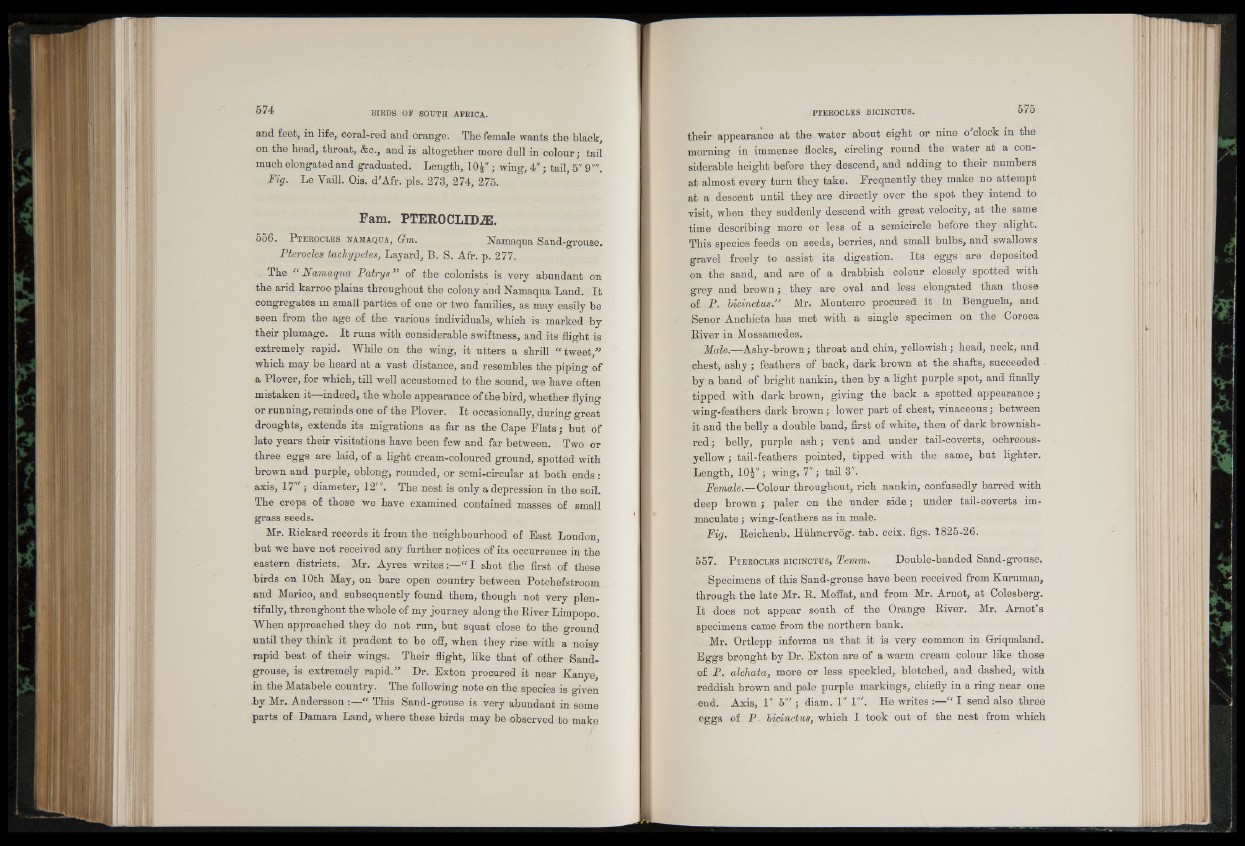
and feet, in life, coral-red and orange. The female wants the black,
on the head, throat, &c., and is altogether more dull in colour ; tail
much elongated and graduated. Length, 10|"; wing, 4"; tail, 5" 9"".
Fig. Le Yaill. Ois. d’Afr. pis. 273, 274, 27,5.
Fam. PTEROCLID^l.
5o6. P t e r o c l e s n a m a q u a , Gm. Namaqua Sand-grouse.
Pterocles tachypetes, Layard, B. S. Afr. p. 277.
The “Namaqua Patrys” of the colonists is very abundant on
the arid karroo plains throughout the colony and Namaqua Land. It
congregates in small parties of one or two families, as may easily be
seen from the age of the various individuals, which is marked by
their plumage. It runs with considerable swiftness, and its flight is
extremely rapid. While on the wing, it utters a shrill “ tweet,"
which may be heard at a vast distance, and resembles the piping of
a Plover, for which, till well accustomed to the sound, we have often
mistaken it—indeed, the whole appearance of the bird, whether flying
or running, reminds one of the Plover. I t occasionally, during great
droughts, extends its migrations as far as the Cape Plats; but of
late years their visitations have been few and far between. Two or
three eggs are laid, of a light cream-coloured ground, spotted with
brown and purple, oblong, rounded, or semi-circular at both ends:
axis, 17'"; diameter, 12'". The nest is only a depression in the soil.
The crops of those we have examined contained masses of small
grass seeds.
Mr. Rickard records it from the neighbourhood of Bast London
but we have not received any further notices of its occurrence in the
eastern districts. Mr. Ayres writes:—“ I shot the first of these
birds on 10 th May, on bare open country between Potchefstroom
and Marico, and subsequently found them, though not very plen-
tifully, throughout the whole of my journey along the River Limpopo.
When approached they do not run, but squat close to the ground
until they think it prudent to be off, when they rise with a noisy
rapid beat of their wings. Their flight, like that of other Sand-
grouse, is extremely rapid." Dr. Exton procured it near Kanye,
in the Matabele country. The following note on the species is given
■by Mr. Andersson :—“ This Sand-grouse is very abundant in some
parts of Damara Land, where these birds may be observed to make
their appearance at the water about eight or nine o clock in the
morning in immense flocks, circling round the water at a considerable
height before they descend, and adding to their numbers
at almost every turn they take. Frequently they make no attempt
at a descent until they are directly over the spot they intend to
visit, when they suddenly descend with great velocity, at the same
time describing more or less of a semicircle before they alight.
This species feeds on seeds, berries, and small bulbs, and swallows
gravel freely to assist its digestion. Its eggs are deposited
on the sand, and are of a drabbish colour closely spotted with
grey and brown ; they are oval and less elongated than those
of P. bicinctus.” Mr. Monteiro procured it in Benguela, and
Senor Anchieta has met with a single specimen on the Coroca
River in Mossamedes.
Male.—Ashy-brown; throat and chin, yellowish; head, neck, and
chest, ashy; feathers of back, dark brown at the shafts, succeeded -
by a band of bright nankin, then by a light purple spot, and finally
tipped with dark brown, giving the back a spotted appearance;
wing-feathers dark brown; lower part of chest, vinaceous; between
it and the belly a double band, first of white, then of dark brownish-
red; belly, purple ash; vent and under tail-coverts, ochreous-
yellow; tail-feathers pointed, tipped with the same, but lighter.
Length, 10|"; wing, 7"; tail 3".
Female.—Colour throughout, rich nankin, confusedly barred with
deep brown; paler on the under side; under tail-coverts immaculate
; wing-feathers as in male.
Fig. Reichenb. Huhnervog. tab. ccix. figs. 1825-26.
557. P t e r o c l e s b ic in c t u s , Temm. Double-banded Sand-grouse,
Specimens of this Sand-grouse have been received from Kuruman,
through the late Mr. R. Moffat, and from Mr. Arnot, at Colesberg.
It does not appear south of the Orange River. Mr. Arnot’s
specimens came from the northern bank.
Mr. Ortlepp informs us that it is very common in Griqualand.
Eggs brought by Dr. Exton are of a warm cream colour like those
of P. alchata, more or less speckled, blotched, and dashed, with
reddish brown and pale purple markings, chiefly in a ring near one
■end. Axis, 1" 5'" ; diam. 1" 1"'. He writes “ I send also three
eggs of P. bicinctus, which I took out of the nest from which